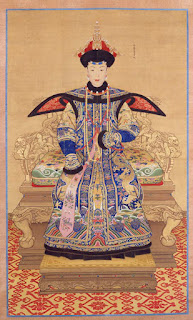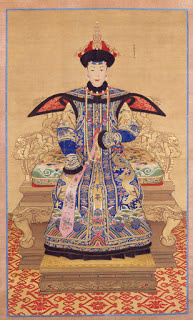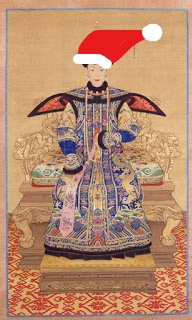Top Five Favourite Dining Spots in Ho Chi Minh City
After my list of fave cafés in Ho Chi Minh City (which, of course, you’ve already read, but if not, click here ), I now present my Top Five Favourite Dining Hangouts in Ho Chi Minh City (HCMC)! Just like the city's cafés, I could rant on about how beloved old haunts have fallen by the wayside, but life is too short and instead, I’ll take Adriana Grande’s mindset – "Thank U, next!" – and share some new / rediscovered finds. Unlike other bloggers and 'influencer's' (whatever that means), who launch into excruciating detail about every mouthful and think they know it all about the food / city they’re writing about (in many cases, not), this Jaded Empress doesn’t profess to being an expert. I just like what I like and will do my darnest to explain why, down to the table arrangements. Vietnam may be a challenging place to live, but these five old / new establishments make me appreciate I’m lucky to be here and able to dine in these establishments.
Pho Hoa Pasteur

Pho Hoa Pasteur is rated as one of Ho Chi Minh City's finest local joints for Pho, Vietnam’s beloved national dish: rice noodles and strips of chicken (ga) or beef (bo), in a complex yet clear broth of main ingredients, green onions, bean sprouts, fresh herbs like coriander and basil and more. This is also Saigon’s oldest pho establishment, allegedly over 70 years (and quite frankly the interiors and kitchens look as much). Today, Pho Hoa is still the beloved, one-notch-up from a hole-in-the-wall eaterie: the communal-style dining tables on the open-sided ground-floor are usually jam-packed with locals who flock here day and night for their pho fix – bus-loads of tourists usually head upstairs for the air-con. Don’t come here on a first date, as it’s so fluorescent-bright, you could land a plane.
Since returning again to Ho Chi Minh City, whoooaaaaaa, I personally have found standards have slipped somewhat for Pho Hoa's legendary pho ga.
The usual mound of rice noodles is drastically reduced and the once lean, white strips of chicken are now invariably grisly, brown cuts that I find almost inedible. And the Cha Gio I so like – southern deep-fried spring rolls, small, thin and tightly packed with vermicelli noodles and shredded vegetable, fried and served piping hot – are a bit of a let-down. With their uniform shape and thick rice paper coating, these look suspiciously factory-made, out of the deep freezer into the fryer and the spicy dipping sauce tastes like it came from a bottle.
So why do I still frequent Pho Hoa? Well they also make by hand yummy Goi Cuon (fresh spring or summer rolls). More synonymous with the tropical south, unlike Cha Gio, these delicious rice paper rolls are longer, thicker in size and super plump, stuffed with sliced shrimp and pork belly and cucumber, coriander and mint and vermicelli noodles– with the signature garlic chive poking out.
Served fresh, this manna from the Gods is dipped in a thick peanut sauce and washed down with a fresh young coconut drink. Other reasons to frequent: tables come laden with complimentary piles of leafy herbs and greens, chilis, bean sprouts and half-cut limes – far more generous than most eateries.
This family-run institution is a living snap-shot of old Saigonese life, where apart from the prices and di rigueur WiFi – even this city icon may have died a death if they hadn’t installed that – not that much has changed down the years. On my first posting, I stated, "Including the kitchens..." but since I wrote this, what d'ya know, the owners revamped the dining area and main open kitchen at the front. Wonder if they took note?
Me Vui
This small, homely eaterie welcomes like dining in someone’s front room, from the polished wood dining tables and country-style ceramics to the simple open kitchen at the rear where staff prepare dishes in full view – a huge vat of simmering broth taking centre stage.
Locals, mostly young couples and families, come to Me Vui for the great-value menu that solely covers legendary dishes from Vietnam’s Central Coast – mainly the royal city of Huế . Me Vui not only gives me a chance to sample some of Vietnam’s most celebrated fare, but a nostalgic journey back to my amazing travels across this wonderful region years ago.
Former Imperial City of Huế was the capital of Vietnam during the Nguyen royal dynasty – 1802 to 1945 – Vietnam’s last Emperors (as far as I’m aware, not my relatives). Most of the dishes and culinary techniques from Huế’s acclaimed cuisine have some link to the Imperial kitchens of Huế’s emperors. Recipes were perfected to suit the royal’s palates, the Imperial Court and its high ranking officials. Royal chefs were forbidden to cook the same meal twice; thus, hundreds of dishes – elaborately hand-prepared and many, miniature-sized – were created to appease and impress impossibly finicky emperors. After the Nguyen emperor dynasty ended, those Imperial treats gradually extinguished among courtly families due to over-elaborate preparatory methods, but thankfully trickled down to Huế’s "commoners,” evolving into today’s acclaimed street food.
Me Vui’s select menu is divided into clear sections, but the star is Bun Huế (Huế Noodles) and arguably Huế's most iconic dish, bún bò Huế (it’s only outside Huế that the city name is used to denote its origin). One of Vietnam’s most popular noodle soups, this is not for the faint-hearted (nor non-beef eaters like me): thick rice vermicelli noodles (bún), beef bones and shank, plus pork, in a spicy broth seasoned with lemon grass, fermented shrimp paste and chili paste. Allegedly, Emperor Gia, his Empress and son Bao Dai were so enamoured with this recipe, they consumed it on a daily basis.
Another Hue speciality, Bún Thịt Nướng, or Noodle BBQ Pork, is actually a delicious cold salad, made with marinated grilled pork (thit nuong), cold rice vermicelli, chopped fresh seasonal green salad, pickles and Huế’s signature peanut sauce with roasted peanuts, topped with nuoc mam fish sauce.
Again, this Huế street food has been embraced throughout Vietnam, but especially in the south. From the Banh Huế (Huếcake) section, I also tried the iconic, Banh Beo, steamed mini rice pancakes topped with ground shrimp and nuoc mam.
Mi Quang Hoi An, a thin rice noodle dish and Goi Ga Hoi An, a salad of soft chicken, onions, young banana and aromatic herbs drenched in a gingery dressing. All the above, best eaten with a refreshing iced yellow bean tea.
To discover this Central Vietnam-focused eaterie in Saigon is a real treat, especially, near to where I live, so too, a few doors down at #22, another Mui Ve outlet dishing-up Hanoi classics, Pho, Bun Cha and Cha Ca Va Long!
Cuc Gach
Quan
And since my return, this has become one of my all-time fave restaurants in Saigon; even on my most jaded days, epitomising why I fell in love with Vietnam over two decades ago.
Amidst Saigon’s manic excesses, Cuc Gach Quan is tucked down sleepy side-street, (#10 Dang Tat, Tan Dinh) in a residential neighbourhood in District One’s northernmost reaches. Through the traditional high wooden door and front dining terrace strewn with fairy lights,
you enter what resembles an authentic northern Vietnamese countryside home.

Actually, it reminds me of Hanoi’s charming ancient tube houses: narrow, deep and cavernous with separate spaces offering varied dining styles and with the signature open-air central water feature dividing the kitchen and dining areas.
Vietnamese countryside ambiance is recreated with touches like old dresser cabinets and wooden dining tables complete with coconut wood chopsticks crammed into old metal cans and woven baskets covering rustic ceramic serving bowls.
Tasteful art works by local artists, ethnic décor and vintage lamps feed the ambiance, along with a background vintage soundtrack. It’s no surprise Cuc Gach Quan was created by a Vietnamese architect turned foodie, putting their heart and soul into renovating this old French colonial mansion into a restaurant, “In memory of my grandmother’s stall” and preserving a small slice of Saigon’s past. Grandmother was even the source of inspiration for the architectural design, constructed with recycled materials and traditional building techniques.
With its “Eat green, live healthy, taste the past” mantra, Cuc Gach Quan focuses on Vietnamese countryside cuisine and flavours, mainly southern dishes with some regional classics. Lovingly recreated, this is rustic home-cooking the traditional – and grandmother’s – way, albeit taken up a notch and washed down with French wines. The emphasis is on farm-to-table, fresh produce and ingredients, especially organic countryside veggies, sourced from their farm north of Saigon. There’s no MSG and other chemical preservatives here, rather, farmer’s fertiliser-free rice and preservative-free tofu, pickles and soya sauce exclusively hand-made for the kitchens. They use as little plastic and nylon as possible and Morning Glory stems double as drink straws (restaurateurs take note!!)
The epic-sized menu features permutations of vegetables, meats, seafood, fish, edible flowers and salads ad infinitum – “Choose to accommodate any veggies the way you want and meat you want!” Once I ploughed through that lot, I sampled simple yet delish dishes: voluptuously plump, fresh spring rolls, stuffed with shrimp and pork and dipped in a thick peanut sauce

and another visit, the fried equivalents
Freshly-squeezed juices come served in a glass bottle with a rolled-up pandan leaf as stopper, accompanied by a shot of honey.
I’ve yet to try the rice and black bean infusions, as I like my pomelo and passion fruit juices too much. The young waiting staff are super-friendly, helping guests decide from the overwhelming menu choices (my waiter handed me the home-made herb jelly (suong san), on the house, for dessert, declaring “This is good for your health!”….geez, do I look that bad?) and appear genuinely happy at work, larking around in the kitchen and proudly showing me around the lovely renovated colonial mansion.
Chi Hoa
Chi Hoa is all about recreating traditional Vietnamese home cooking, generations-old recipes and warm intimate family meals nostalgically harking back to bygone times – in danger of fast disappearing in modern-day life. These home-style regional dishes are carefully prepared with natural, seasonal ingredients for ultimate freshness.
“Chi Hoa” means “flowers,” a common name in Vietnam for women and this restaurant pays homage to those instilling love into every meal they cook for their families. So make sure you head to the correct Chi Hoa: a new one has opened in the former Moi Moi restaurant by Luke Nguyen (#97 Hai Ba Trung). But Chi Hoa’s rustic home-cooking focus doesn’t quite match these modern stylish premises, so dine instead at the original Chi Hoa (31A Lê Thánh Tôn Street), a sweet and homely two-storey bistro with an open kitchen half-way up the stairs.
Staff are super friendly (despite some outrageously rude east Asian tourists) and will helpfully advise on dishes from the comprehensive menu: Breakfast Banh Mi (baguette-style sandwiches), plus Rice, Salads and Noodle Bowls highlighting seafood, pork, beef, chicken and vegetables, along with vegetarian options. Of note are stir-fried vermicelli with ginger sauce topped with crispy soft-shell crab and mango salad with pork belly and sun-dried gourami fish; well-seasoned, juicy prawn dishes and bubbling hot pots (Lau).
Dishes I’ve sampled cover crispy fried brown rice with lotus seeds and diced veggies
And of course, yummy fresh spring rolls, but especially, Goi Cuon Ca Thac Lac, crispy featherback fishcake and dill
a divine alternative to the usual shrimp ‘n’ pork suspects, although these are pretty good too, like the fried varieties here, dipped in fish sauce (nuoc mam)
For drinks, the coconut and kumquat juice, or lemongrass and pandan leaf juice infusion with chia seeds and jelly are pure Asia in a glass.
Evoking a traditional family kitchen, food and condiments are served in lovely hand-painted ceramics pottery and fresh-cut flowers adorn the tables.
Even ordering a pot of fragrant lotus tea is Instagram-worthy, presented in prettily decorated, traditional teapots and cups.
Propaganda Vietnamese Bistro
This relaxed yet buzzing Vietnamese themed café-bistro is another of my all-time go-to places and for me, the epitome of the new Saigon. Propaganda (21 Han Thuyen, District One) is conveniently located downtown, sandwiched between iconic Notre Dame Cathedral and Reunification Palace and edging one of central Saigon's few remaining green spaces and is housed in a row of picturesque French colonial shop-houses.

Next door neighbour, Au Parc, is under the same foreign management and a handy Plan B, should Propaganda’s multiple air-conditioned floors get overrun – which invariably, they do. Besides the location, one of Propaganda’s main selling points is, as the name suggests, sensational propaganda-style murals plastered over the main walls.

This vividly coloured propaganda art, inspired by those Communist-style retro posters (as detailed in my related post, which, of course, you’ve already read) and hand-painted by local artisans is replicated throughout, even down to the graphics on the menu and napkins.
Ironically, I invariably end-up sitting outside, on the lovely street-side terrace facing the leafy park (and a few parked motorbikes, well, this is Saigon).....
armed with a pre-dinner cocktail, which come very decent priced, especially during Happy Hour, with 30 percent knocked off. Signature cocktails feature gems like Saigon Heat (lime leaf infused Bacardi rum, Malibu, lemongrass syrup, lime, chili, etc), but I usually plump for the Classic, Passionfruit Mojito
.

The menu is self-declared “Twisted Vietnamese Cuisine,” or Vietnamese home cooking “redesigned:” creative modern twists and contemporary interpretations of traditional Vietnamese dishes and street food classics from the north, central and south – all prepared with the freshest, safest ingredients. Propaganda even offer a special menu pairing dishes with fine wines, but always cleverly avoiding any “fusion confusion.”
Ideal for those who wish to sample Vietnam’s fabulous street food – albeit with modern twists – minus “the street” and its kindergarten-style plastic stools, traffic fumes, dodgy hygiene and lack of personal space.
There’s a wide selection of Vietnamese spring rolls, but with tweaks on this classic fried or fresh dish; swapping in more unusual ingredients, such as chicken and avocado and with modern variations like duck in betel leaf with spicy ginger fish sauce. The ultimate comfort food, these are cut into bite-sized pieces that are easier to eat and share – perfect with cocktails.
 |
This is my plate of yummy fried spring rolls with chicken and prawn, before they got demolished.
From the Banh Mi, Rice, Noodles, Soups & Salads sections, I sampled the Vietnamese wild pepper and green mango salad with BBQ chicken and shallots, sprinkled with peanuts. Hmmmmm, sorry guys, this is a modern twist too far; a classic Vietnamese salad, but here, with far more lettuce than shredded green mango, etc, so it tastes like a "standard" western salad. Having said that, hell, it's still yum.
I also recommend the divine, home-made coconut ice-cream, but next time, intend to try the soursop and sugar cane variety.
Along with the hip locals, expats and tourists that flock here, I’m a happy-chappy; even more so as Propaganda use paper straws and their friendly, savvy staff wouldn’t dream of greeting me with, “Just one, Madam?”





















































Oh how I miss the banana flower salad. Love your food descriptions and the pics are fabulous. Decor of Propaganda Cafe is enchanting!
ReplyDelete